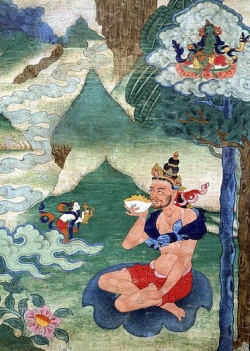Niànfó
Nianfo (Chinese: 念佛, pinyin: niànfó; Japanese: 念仏 [[nembutsu]]; Korean: 염불 yeombul; Vietnamese: niệm Phật), is a term commonly seen in the Pure Land school of Mahāyāna Buddhism. It derives from the Sanskrit term buddhānusmṛti, which means "mindfulness of the Buddha." In the context of Pure Land practice, it generally refers to the repetition of the name of Amitābha Buddha.
Indian Sanskrit Nianfo
Although the Sanskrit phrase used in India is not mentioned originally in the bodies of the two main Pure Land sutras, it appears in the opening of the extant Sanskrit Infinite Life Sutra as the following:
namo'mitābhāya.
The apostrophe and omission of the first "A" in "Amitābha" comes from normal Sanskrit sandhi transformation, and implies that the first "A" is implied and spoken more quickly. A more accessible rendering might be:
Namo Amitābhāya.
The phrase literally means "Homage to Infinite Light". The Sanskrit pronunciation is the following:
[nɐmoːɐmit̪ɑːbʱɑːjɐ]
Nianfo in Various forms
As the practice of nianfo spread from India to various other regions, the original pronunciation changed to fit various native languages.
In China, the practice of nianfo was codified with the establishment of the separate Pure Land school of Buddhism. The most common form of this is the six syllable mantra; some shorten it into Āmítuó Fó.
Purpose of Nianfo
Regarding Pure Land practice in Indian Buddhism, Hajime Nakamura writes that as described in the Pure Land sūtras from India, Mindfulness of the Buddha (Skt. buddhānusmṛti, Ch. nianfo) is the essential practice. These forms of mindfulness are essentially methods of meditating upon Amitābha Buddha.
In the Śūraṅgama Sūtra, Mahāsthāmaprāpta Bodhisattva tells of how he gained enlightenment through the practice of nianfo, or continuous pure mindfulness of Amitābha, to obtain samādhi.
In Chinese Buddhism, the nianfo is specifically taken to be a type of mantra used in meditation, and it is often practiced while counting with Buddhist prayer beads. In China there is also the combined practice of Pure Land and Chán. As taught by Venerable Nan Huai-Chin, the nianfo is chanted slowly, and the mind is emptied out after each repetition. When idle thoughts arise, the nianfo is repeated again to clear them. With constant practice, the mind progressively empties and the meditator attains samādhi.
In most Pure Land traditions, mindfully chanting of the name of Amitābha Buddha is viewed as allowing one to obtain birth in Amitābha's western pure land called Sukhāvatī (skt. "Realm of Bliss"). It is felt that this act would help to negate vast stores of negative karma that might hinder one's pursuit of buddhahood. Sukhāvatī is a place of refuge where one can become enlightened without being distracted by the sufferings of our existence.
Various Pure Land schools in Japan have different interpretations of the nianfo, often based on faith in Amitābha rather than on meditation. In the Jodo Shinshu Buddhist tradition, the nianfo is reinterpreted as an expression of gratitude to Amitābha Buddha. The idea behind this is that rebirth into Sukhāvatī is assured the moment one first has faith in Amitābha.
Origins of the Nianfo
The earliest dated sutra describing the nianfo is the Pratyutpanna Samādhi Sūtra (first century BCE), which is thought to have originated in ancient kingdom of Gandhāra. This sutra does not enumerate any vows of Amitābha or the qualities of Sukhāvatī, but rather briefly describes the repetition of the name of Amitābha as a means to enter his realm through meditation.
"Bodhisattvas hear about the Buddha Amitabha and call him to mind again and again in this land. Because of this calling to mind, they see the Buddha Amitabha. Having seen him they ask him what dharmas it takes to be born in the realm of the Buddha Amitabha. Then the Buddha Amitabha says to these bodhisattvas: 'If you wish to come and be born in my realm, you must always call me to mind again and again, you must always keep this thought in mind without letting up, and thus you will succeed in coming to be born in my realm."
Both the Immeasurable Life Sūtra (Larger Sukhāvatīvyūha Sūtra) and the Amitābha Sūtra (Smaller Sukhāvatīvyūha Sūtra) subsequently included instructions for practicing nianfo in this manner. However, it has not been determined which sūtra was composed first, and to what degree the practice of this form of nianfo had already been popularized in India. Nianfo directed at other buddhas and bodhisattvas is also advocated in sūtras from this period, for figures such as Akṣobhya Buddha and Avalokitasvara Bodhisattva.
The practice of nianfo for Amitābha Buddha became very popular in India. With translations of the aforementioned sūtras as well as instruction from Indian monks, the practice rapidly spread to East Asia.
Nembutsu-ban
The term nembutsu-ban is applied to the event in Kyoto, Japan in 1207 where Hōnen and his followers were banned from the city and forced into exile. This occurred when the leaders of older schools of Buddhism persuaded the civil authorities to prohibit the newer practices including the recitation of Namu Amida Butsu.[8] The ban was lifted in 1211.
Nianfo in Modern History
Thích Quảng Đức, a Vietnamese Mahāyāna monk who famously burned himself to death in an act of protest, said the nianfo as his last words immediately before death. He sat in the lotus position, rotated a string of wooden prayer beads, and recited the words "Nam Mô A Di Đà Phật" before striking the match and dropping it on himself.



